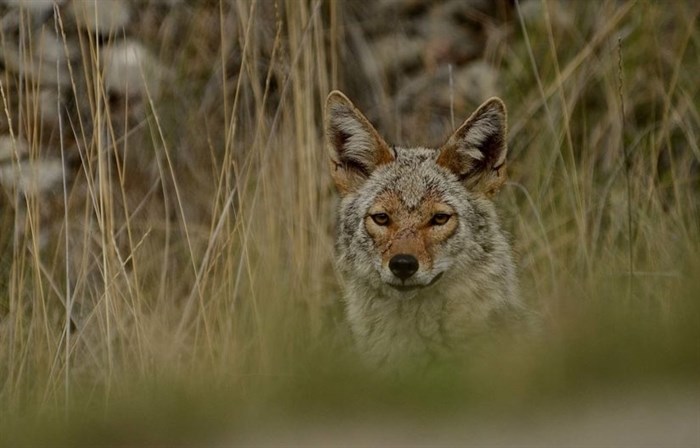
Interior residents are reminded to increase their awareness of coyotes as we enter their mating season, and the potential for a conflict between a person, pet, and coyote increases.
Image Credit: BCSPCA/ Tania Simpson
January 24, 2022 - 6:00 AM
Southern Interior residents are reminded to increase their awareness of coyotes as the potential for conflict between a person, their pet and a coyote increases during mating season.
Coyotes typically mate from late January to mid-March and will have, on average, five pups from April to mid-May.
“Coyotes could perceive another canine as a potential rival, there’s more aggressiveness that could happen this time of year. It’s always good to keep pets separated from wildlife,” WildSafeBC program manager Vanessa Isnardy said. “Coyote densities will vary across the province, but the Interior is prime coyote habitat.”
Coyote ranges have expanded, as they have adapted to living in urban environments.
Although coyotes can help with mouse and rodent control, they can also cause conflict with young or small livestock, or with people walking their pets.
To prevent conflicts with coyotes, WildSafeBC encourages pet owners to keep their pets indoors at night and keep pets close on a leash at dusk and dawn when predators are actively hunting.
Interior residents can also keep garbage bins and compost bins secure, pick up pet waste, remove dense landscaping or low branches, seal off spaces under porches, sheds and decks with wire mesh, and install motion-activated lights to deter coyotes.
Pups are born into dens dug into the soil. Coyotes will also expand holes or dens that were previously created by badgers, marmots, rabbits and rodents. Logs, rock crevices or underbrush can also be used as a den, but it’s not common, Isnardy said.
READ MORE: iN VIDEO: Drone captures coyotes prancing around on Skaha Lake
“As the season progresses and they have pups, coyotes will be more protective of their offspring and busy getting food for their offspring,” Isnardy said. “It’s best for people to be really cautious when walking their pets.”
When coyotes have pups, they can become protective of their dens, she said if you see a coyote or a pair following you, it’s known as “escorting” and they are ensuring you are leaving the area.
If a coyote approaches you or your pet, WildSafeBC recommends making yourself appear large, maintain eye contact, speak in a low firm voice and pick up small pets and children immediately, but don’t run or turn away as it could trigger an attack.
If the coyote continues to approach, continue looking large and making noise while you slowly retreat, moving towards more people or into your home or vehicle, Isnardy said.
“If the coyote attacks, deliver a series of blows either with your feet or a sturdy stick at the animal’s ribs and stomach,” she said.
Conflicts with coyotes or unusual coyote behaviour can be reported to the Conservation Officer Service at 1-877-952-7277.
To learn more about coyotes, visit the WildSafeBC website here.
To contact a reporter for this story, email Emily Rogers or call 250-718-0428 or email the editor. You can also submit photos, videos or news tips to the newsroom and be entered to win a monthly prize draw.
We welcome your comments and opinions on our stories but play nice. We won't censor or delete comments unless they contain off-topic statements or links, unnecessary vulgarity, false facts, spam or obviously fake profiles. If you have any concerns about what you see in comments, email the editor in the link above.
News from © iNFOnews, 2022